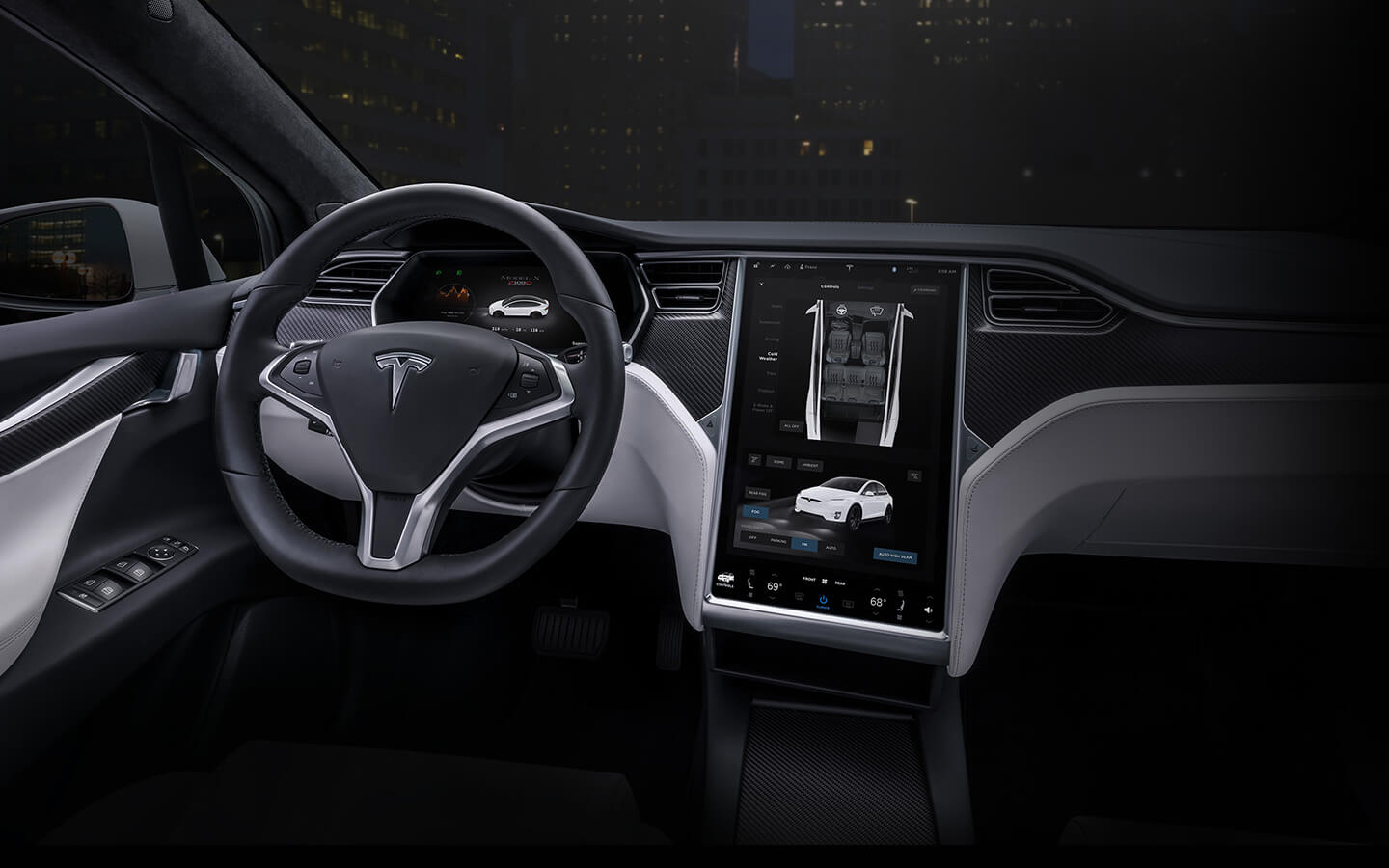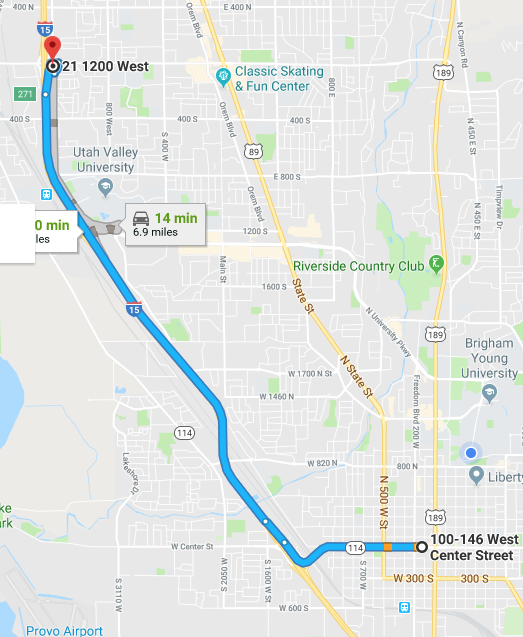The Tesla Model X is the most popular electric vehicle in Utah, according to a recent report.
To see what all the buzz is about, I test-drove the Model X over the Memorial Day weekend and came away with a clear idea of where automobiles are going. From my perspective, electric vehicles have a chance to spark some life into an oil-dominated industry.

At 12:55 p.m. on May 26, I arrived at the Provo Marriott Hotel & Conference Center where both the Model S sports car and the Model X were on display. While both vehicles are sleek and stylish, they blend in well with traffic and aren’t an eyesore. The Model X features a set of falcon wing doors that open vertically. I thought they were cool, but they’ve proven to be a polarizing feature among car critics and enthusiasts.
After checking in, a Tesla representative walked me to a shiny white Model X. While walking up to a car is a relatively mundane event, The Model X managed to make a great first impression: The driver-side door opened up without any interaction on my part. While the representative confirmed this was only enabled for the test-drive (Tesla owners will need to enable the feature using a special NFC card or smartphone app), it seemed to tell me I was in for a unique experience.
The interior
After climbing into the driver seat and letting the door close behind me, I noticed the neo-futuristic style of the interior. Unlike most vehicles, the Model X features a massive panoramic windshield that extends up and over your head, resulting in a very open, freeing feeling. The regular claustrophobia I experience in most other cars was mostly gone.
A traditional radio and control console was replaced by a giant touchscreen display. After tapping around for a few minutes, I found I could customize everything from braking and accelerating to door settings, climate control, seat temperature, speaker tone and a full suite of navigational features and diagnostics.

The steering wheel also features a handful of buttons and dials to adjust the radio volume and manage the gear shift, turn signal and the Tesla Enhanced Autopilot toggle, a feature I was able to experience. I felt comfortable and confident operating the car after a brief tutorial.
Behind the wheel, a traditional speedometer and tachometer have been replaced by a digital heads-up display. The display features distance traveled, radio and music information, current battery charge, navigational maps and a digital representation of the Model X and its surroundings.
Sensors on the car can detect lines and vehicles on the road, which are shown on the screen. I found myself glancing down every few seconds to check what was around me. By the end of my drive, this feature became just as vital to me as the rear-view mirrors.
The car seats themselves boasted a synthetic leather finish and were firm but comfortable. Some light ergonomics provided back support, and a few knobs on the side helped me adjust each part of the seat for maximum and individualized comfort. I was able to scoot the seat forward and adjust the steering wheel in a matter of seconds, making my time in the Model X the best driver’s seat experience.

Besides the front driver seats, the Model X features two additional rows of seating, allowing up to seven passengers to ride comfortably. Leg space in the third row is fairly restrictive, but still more comfortable than in some other SUVs. Both rows of seats can also be laid down, allowing for extra cargo or enough room to lay out a couple of sleeping bags.
The navigation system built into the Model X was one of the most outstanding features for me. The map displays functions like GPS or smartphone navigation and showcases a huge map with many points of interest marked on the screen. With a few taps, I was able to map a trip to Flagstaff, Arizona. The car automatically mapped out two supercharging stations along the way and gave me battery percentage and time estimates for each location.
This feature could prove to be vital for Tesla owners who love road tripping. It’s relatively easy to find a gas station to refuel a traditional combustion engine-driven vehicle. But since charging stations — let alone Tesla-branded Superchargers — are still relatively uncommon in Utah, knowing exactly where you need to go to recharge would provide a lot of reassurance.
On the road
After acquainting myself with the Model X’s functions, I was tasked with backing out of the parking spot. I found it a little confusing at first to use the car’s display screen to back up, but a few white lines quickly popped up onscreen to show me exactly how to turn. I still felt more comfortable physically turning in my seat to watch out the back window of the car, but I can imagine parents with rambunctious children or drivers with a full trunk could find the feature to be a lifesaver.

As I drove west down Provo’s Center Street, the car’s regenerative braking system immediately stood out to me. As you let off the acceleration, the Model X immediately applies a brake that generates spare electricity and kicks it back into the car’s battery. This feature took a few minutes to get used to. It reduced my need to actually use the brake pedal, but the brake’s efficiency and heavy feel meant I had to adjust my stopping distance. Rather than let off the acceleration about 10 feet before my stop, I found myself feathering the acceleration up to about five feet before a stoplight.
After getting onto I-15 heading north, I tested the acceleration capabilities, causing the Model X to speed up faster than I expected. The car is incredibly fast and smooth and is whisper-quiet. Tesla estimates that it takes roughly 2.9 seconds to go from zero to 60 mph, and I could definitely feel that speed. The sensation is similar to a plane’s takeoff, and I found myself lightly pressed into the seat.
After pulling into a middle lane on I-15, the Tesla representative recommended I try out the Model X’s biggest talking point: Enhanced Autopilot. I’ve always thought the idea of self-driving cars was unique, and futuristic. However, in practice, I found the experience to be the most tense and terrifying couple of seconds I’ve ever spent in a vehicle. After several years of driving and walking away from two car accidents, I’ve been conditioned to always have my hands on the wheel and my eyes on the road. Autopilot challenged me to throw those instincts out the window.
I rotated a dial to set the car’s following distance to a maximum seven feet and flicked the Autopilot toggle twice, which passed control to the car. My heart raced and my stomach churned as I took my hands off the wheel. For the next few seconds, my anxiety spiked. I felt relatively safe, but I found it hard not to be concerned, especially since I was traveling along a busy freeway at 80 mph.
I was pleasantly surprised the Model X’s sensors were capable of reading lines on the road and staying in a specified lane at the designated speed limit. The Model X will brake and adjust speed as necessary, resulting in a fairly smooth ride. To change lanes, I simply toggled the turning signal, and the car waited for a safe opportunity to change lanes.
As we neared our exit on 800 North in Orem, the Model X gradually slowed itself before sounding a chime, which indicated I needed to take over by tapping the brake. According to the Tesla representative, the Enhanced Autopilot feature was developed specifically for freeway and highway use. Although it can be enabled on city streets, it’s recommended that drivers stay aware of their surroundings and react accordingly to changing traffic conditions.
Should you buy a Tesla?
Overall, my 30 minutes driving a Tesla Model X were positive. It’s a luxury vehicle, but not just because of its starting $79,500 price tag. The navigation and autopilot features were impressive and managed to mitigate a lot of stress I feel while driving. However, it’s important to note that these features aren’t foolproof, and Teslas are still prone to traffic accidents related to autonomous driving.
The biggest draw for driving a Tesla, or any electric vehicle for that matter, is its impact on the environment. Gasoline cars accounted for most carbon dioxide and carbon monoxide pollution in 2014, according to the Environmental Protection Agency. Additionally, the EPA reported that 28 percent of greenhouse gases emitted per year in the United States are caused by transportation.
While cruising in an electric vehicle won’t solve atmospheric pollution overnight, it’s a start. In Utah, the annual inversion is often exacerbated by carbon dioxide, according to The Daily Universe. Electric vehicles are one way people can reduce their carbon footprint over a lifetime.
The biggest downside to driving an electric vehicle in Utah is the relative lack of charging stations. According to Tesla, only 14 supercharging stations are readily available in Utah, with another planned for installation in Provo in 2019.

Without these quick-charging stations, Tesla owners will need to charge their vehicle at home or find a local destination charger. These locations are often located at hotels or other lodgings and only serve patrons or customers. If you can find a place to charge, you’ll likely save a bit of money that would otherwise be spent on gas.
Tesla’s high price tags will likely deter many from making the switch. According to Nerdwallet, the Model S starts at $74,500, which is $5,000 less than the Model X. However, various customization options and add-ons, like Autopilot or increased range, will nearly double the cost.
While Tesla does offer reservations on the $35,000 Model 3 sedan, production for most vehicles won’t be finished until 2019. Until then, prospective Tesla owners can take advantage of tax incentives and rebates to shave $7,000 off the high price tag.




